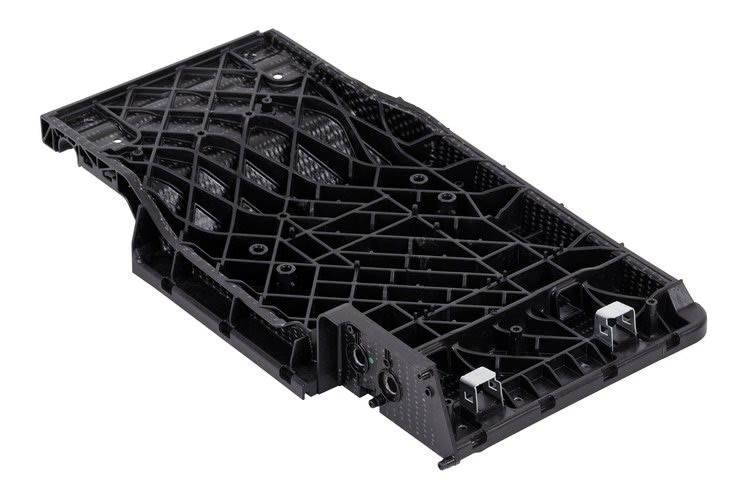 Tepex dynalite continuous-fiber-reinforced, semi-finished thermoplastic composites are now finding new applications in vehicle interiors. One example is the backseat system of an offroad vehicle made by a European automobile manufacturer. The center backseat is equipped with a load-through that enables the backrest of each seat to be folded down individually. This load-through component is produced by shaping and back-injecting Tepex dynalite. “The part marks the entry of this composite material into the lightweight design of backseat systems and is further evidence of its enormous potential in series production applications,” says Henrik Plaggenborg head of Technical Marketing & Business Development Tepex Automotive.
Tepex dynalite continuous-fiber-reinforced, semi-finished thermoplastic composites are now finding new applications in vehicle interiors. One example is the backseat system of an offroad vehicle made by a European automobile manufacturer. The center backseat is equipped with a load-through that enables the backrest of each seat to be folded down individually. This load-through component is produced by shaping and back-injecting Tepex dynalite. “The part marks the entry of this composite material into the lightweight design of backseat systems and is further evidence of its enormous potential in series production applications,” says Henrik Plaggenborg head of Technical Marketing & Business Development Tepex Automotive.“The new component is more than 40 percent lighter than its steel counterpart. At the same time, this safety-relevant component withstands all load scenarios, because the orientation of the continuous fiber layers in the only two millimeter-thick semi-finished product is designed to bear the mechanical stress,” explains Harri Dittmar, project manager and Tepex applications specialist. Tepex is manufactured by LANXESS subsidiary Bond-Laminates GmbH, which is based in Brilon, Germany.
The lightweight component was developed by Brose Fahrzeugteile GmbH & Co. KG with support from the LANXESS High Performance Materials business unit. Brose manufactures the component at its site in Coburg, Germany
Strong in case of front and rear crashes
For functional reasons, the load-through is only mounted on one side, at the top of the rear seat’s backrest. Because of its position, it is exposed to both bending and torsion forces. To withstand these load scenarios, a special multiaxial design was chosen for the continuous-glass-fiber layers in the thermoplastic composite. Multiaxial Tepex is a new development from Bond-Laminates, which makes the composite sheets significantly stronger than before by combining the Tepex fabric with tapes in a technically complex process. The semi-finished product for the load-through has a core consisting of four layers, each 0.25 millimeters thick, which have a fiber orientation of +45 and -45 degrees relative to the component’s longitudinal axis and are arranged symmetrically. They absorb the torsion forces. In contrast, the bending forces are absorbed by the two outer layers, each 0.5 millimeters thick, in which 80 percent of the continuous fibers are in the direction of force. “In case of a frontal collision, this multiaxial layer design ensures that the lightweight component withstands the impact of the accelerated load in the trunk and, in case of a rear collision, the inertia forces pressing the passenger into the seat,” explains Dittmar.



